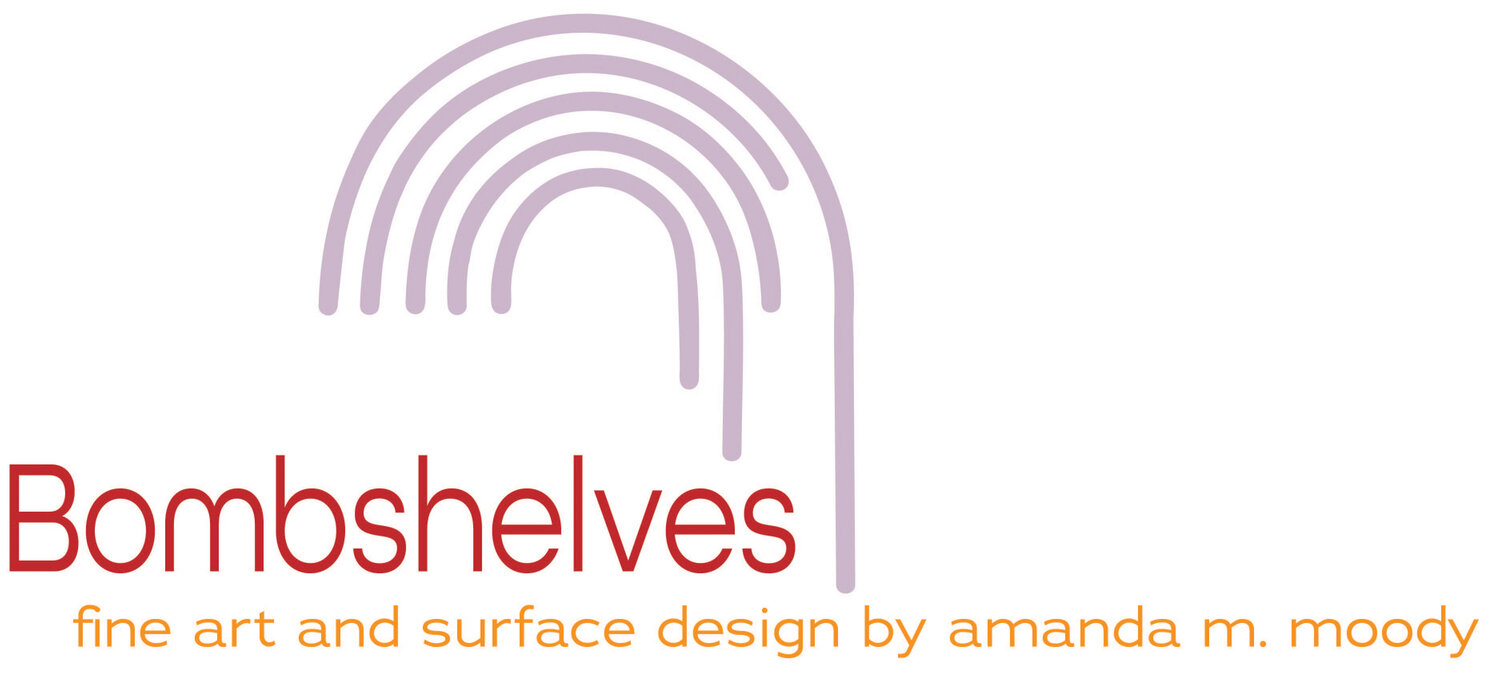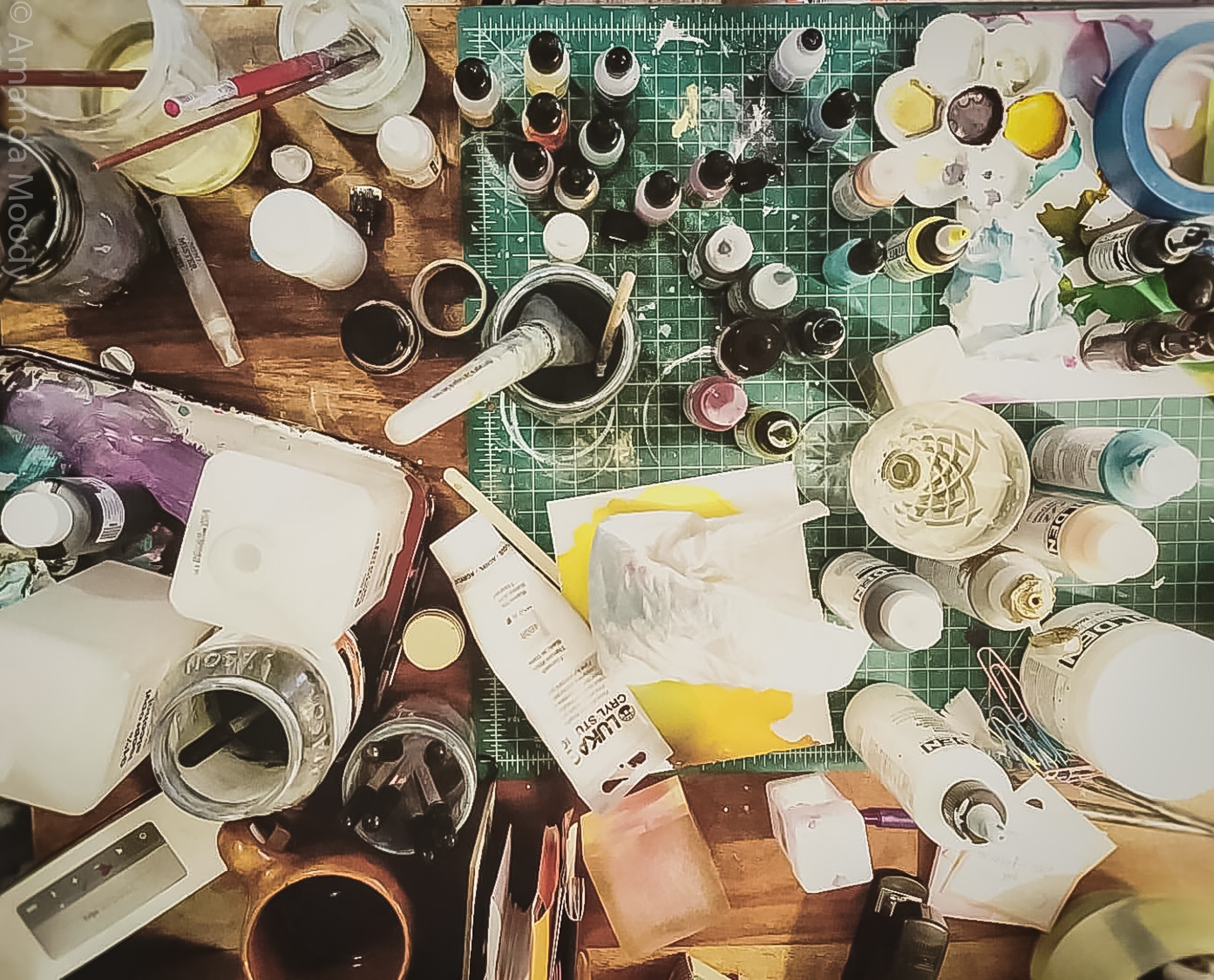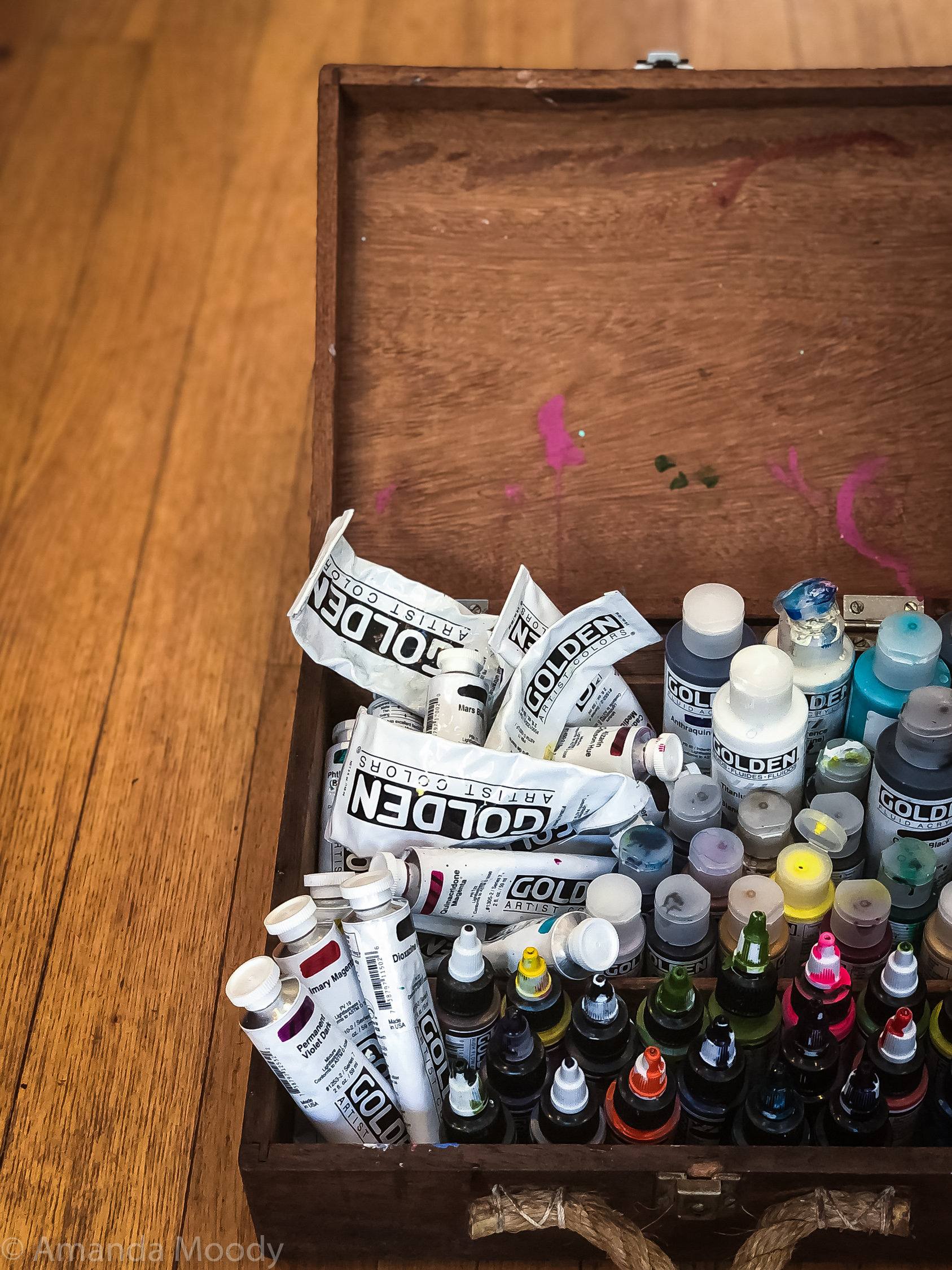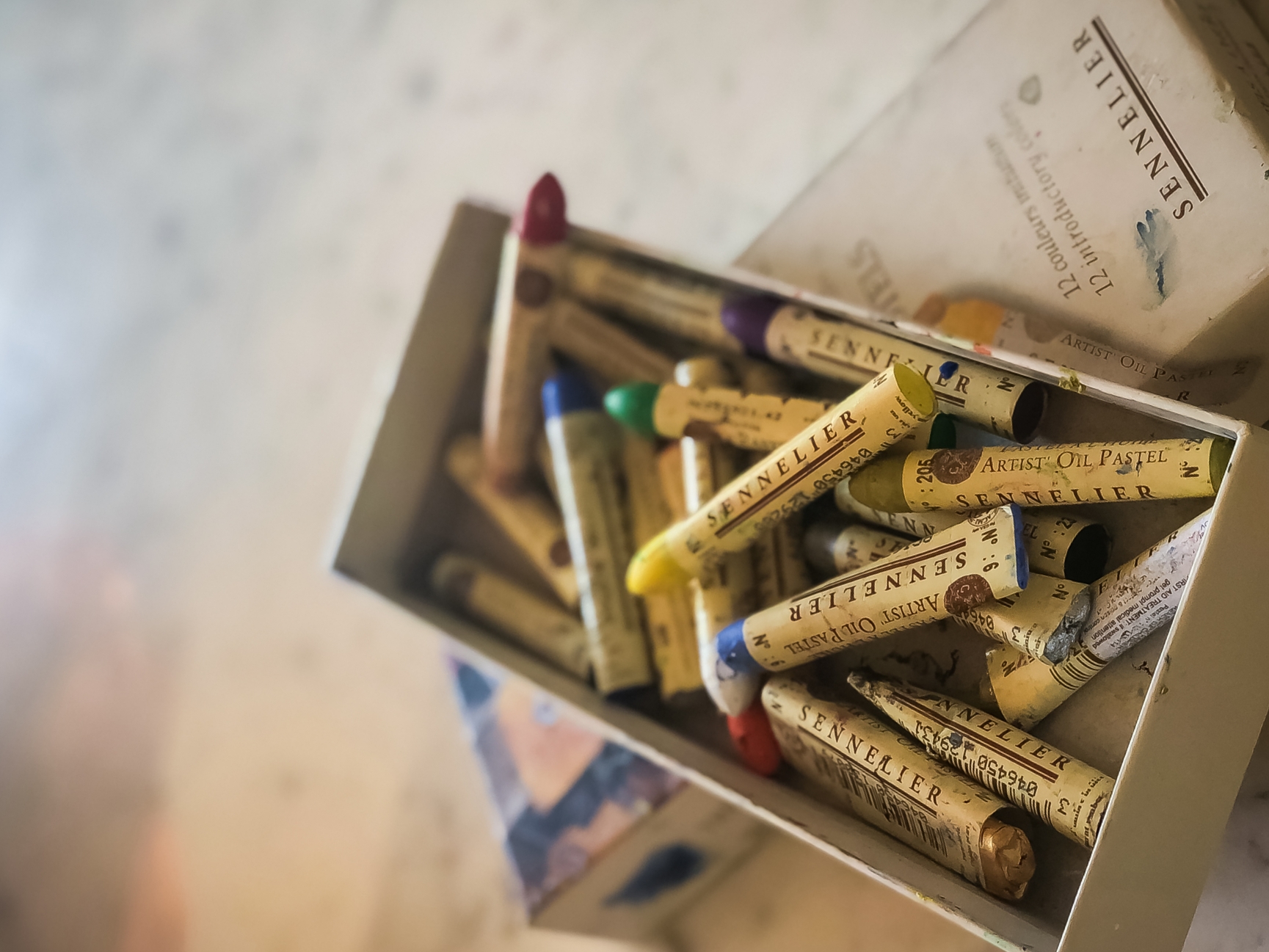I’ve been asked quite frequently what supplies I use for certain techniques in my art. While I highly encourage any artist to simply experiment on their own to find what works for them, I am happy to share the materials and tools that I have come across that are now standbys for my work. So here are some of my absolute essential mediums and tools that I currently rely on in my studio.
MEDIUMS
1 Golden Wetting Agent. Formerly called Acrylic Flow Release, Golden changed the name when they updated their packaging. I freaked out when I thought it had been discontinued…clearly it’s one of my necessities if I’m listing it here first (Thanks for punking me, Golden)! I add a few drops of this to my brush water to increase the flow of acrylics and watercolors, and extend drying time for workability. Experimenting with effects during different stages of the drying process is one of my favorite ways to develop a painting. When used in the correct ratio, Wetting Agent also prevents crazing once dry, and a very little goes a long way.
2 Golden Clear Leveling Gel. Not only do I use this as a medium for paint, I also apply a clear coat of this over my paintings right before I pour the first layer of resin. It helps to minimize that pesky bubble formation, and saves innumerable hours and dollars in the process.
3 Gamblin Cold Wax Medium. For creating texture, dimension and adding translucency on panels that will not be coated in resin (one of the very few things to which epoxy resin does not adhere).
4 Golden Soft Gel Gloss, Molding Paste, Glazing Medium….really any of Golden’s mediums are my texture-makers, and most, if not all can be resined over. I swear I’m not affiliated with this phenomenal company; Their products just always seem to be in the range of exactly what I need. My best advice to you is to experiment, experiment, experiment.
5 Golden GAC 100. My go-to for mixing up pigments. Also used as a coating when I paint an unprimed wooden panel to prevent support induced discoloration and warping.
6 Gamblin Gamvar Varnish. Used when I need a varnish for a mixed media painting that contains oil paint.
7 Gamblin Gamsol. My first choice for archival odorless mineral spirits when oil painting, to adjust fluidity.
8 Krylon UV Resistant Clear Acrylic Coating. For archival UV protecting acrylic/alcohol inks that will not have a resin coating, when I want to minimize varnish brush marks.
9 Winsor & Newton Gloss or Satin Varnish. Used occasionally as a spray varnish in place of brush-on Gamvar.
10 Dux Quick-Dry Gilding Size. Adhesive for gilding metallic veins throughout my paintings.
11 ArtResin. The epoxy resin to end all others. Crystal clear application, UV resistant and non-yellowing, and as low VOC as an epoxy can be. Plus, their customer service is top notch to boot. It’s difficult to find, but ArtResin’s shipping is lightning fast.
TOOLS
12 Royal and Langnickel Aqualon brushes. I try to steer away from plastic in my studio as much as possible, but these brushes are one exception. Since I use so many fluid materials, my brushes take a beating by soaking all day. These gorgeous, clear acrylic brushes have synthetic hair (I also refuse to use any animal hair brushes in my studio) and have a great resilient springback. The handle will not crack or split even if left ignored in a jar of alcohol or water for days (guilty). Plus, they are super economical.
13 Daler Rowney Simply Simmons Size 50 Brush. I feel like I need to do a Before and After makeover shoot for this brush. Since it has a wooden handle and I have the tendency to ignore it, I have bought it several times (my bad…NOT DR’s)…I abuse it so much but keep coming back to this shape and size. Luckily, it’s another budget-friendly choice.
14 Purdy paint brushes. A basic hardware store find, but they are a general workhorse in my studio for initial washes, backgrounds, and applying varnish. It’s difficult to find a large, inexpensive multi-purpose brush that doesn’t shed…and Purdy fits the bill for me.
15 Stainless palette knives. I buy these cheaply in bulk from Amazon, as my palette knife technique is highly abstract and not precise in the slightest. All that I ask in a palette knife is a certain amount of give and thickness for scooping out heavier paint, mediums and gessos.
16 Metal butcher pans. Another non-plastic tool that I use for mixing heavier bodied pigments and paint. I need a palette with a decent lip for encouraging mess making, and something that is simple to scrub clean.
17 Porcelain palettes. Easier to clean and easier on the environment than plastic, these are the Le Creuset pot of my art studio. Nothing sticks to them or stains them.
18 Mason jars and recycled kitchen jars. Glass only for brush fluids and mixing individual colors of paint. Only drawback to these is that I also use these for drinking glasses, and sometimes mistake my paint water for a smoothie or kombucha. Or vice versa.
19 Porter Cable 1500-Watt Heat Gun. For popping resin bubbles and speeding the drying time of paint. I’ve had this particular inexpensive guy for six years now i think, and it’s still going strong with weekly use.
20 Badger TC Aspire Pro air compressor/Badger 150-7 Airbrush Gun. This is my smaller indoor airbrush setup. I also have a larger oil-based compressor for larger spray areas, but I find myself using this one more frequently for detail work, my fave stage of the process.
21 Glass eye droppers. For rationing out pigment and mediums and splatter paint techniques. And sometimes I might just like to pretend I’m a mad scientist.
22 Respirator mask and filters. I have been blessed with asthma, but even if you don’t have health issues, a mask is essential for preventing the inhalation of sawdust, airborne paint, and higher-VOC mediums.
23 Kobalt 42in steel Collapsible/Adjustable Saw Horse. I had a set of heavy plastic saw horses for a while, but my paintings were getting larger and larger and one day, they finally collapsed under the weight and nearly flattened my dog. So, I invested in these steel bad daddies. They fold up easily when I travel with my work, and can withstand the weight of even my largest pieces.
PAINT, INK AND OTHER COLOR-BLOB MAKERS
24 Golden Acrylic Paints. Again with the Golden, you say? Yes. The pigment concentration, intensity and color range is unsurpassed in my opinion, as far as acrylics are concerned. Whatever consistency I choose, be it High Flow, Fluid, or Heavy Body, I can intermix endlessly and get whatever color and texture I have in my brain down onto a surface without fail. Y’all know I am not afraid of color, and Golden’s gorgeous hues will forever be right alongside me at work.
25 Ranger Tim Holtz Alcohol Inks. I don’t use alcohol inks in all of my paintings, but when I do, these are the only one I use. Ranger inks are acid free, and the hues are spot on in my preferred color palette. Most shades are highly concentrated, so they allow for an even larger range of colors and textures in my work.
26 Daler Rowney FW Water-Resistant Acrylic Inks. I am finding myself turning to FW acrylic inks more and more these days. I use them both in a watercolor application and as a more concentrated fluid acrylic. They have a very high level of lightfastness, which is so important to me in producing fine archival work.
27 Jacquard Pearl-Ex Pearlescent Pigments. I love to use these mixed with GAC-100 to create my own paint. They have a stunning range of metallic colors that I would bling all over everything if I could.
28 Sennelier Oil Pastels. Oh, Sennelier, where do I start? These are the most heavenly pastels to use. Buttery, almost paint-like consistency that is unsurpassed. I adore their tactile quality and my hands are usually stained with their phenomenal range of colors. Side note: I was able to visit the Sennelier shop in Paris this year…the exact one across from the Louvre where Picasso used to buy his supplies. Le sigh…
28 Dr. Ph. Martin’s Black Star India Ink. The blackest of all black inks that is the complete absence of color, black as night, black as a cat, black as your ex’s heart…I wish they made this in a black liquid eyeliner. I practically buy this stuff by the case.
So there you have it…my holy grail art supply list. Throw me a line and let me know if I am missing out on something absolutely incredible…I’m always testing out new materials and expanding my repertoire. What are YOUR go-to’s in your studio?
Au Revoir!
Amanda




